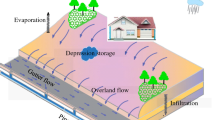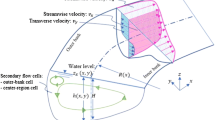Abstract
The Danshui River estuarine system is the largest estuarine system in northern Taiwan and is formed by the confluence of Tahan Stream, Hsintien Stream, and Keelung River. A comprehensive one-dimensional (1-D) model was used to model the hydrodynamics and cohesive sediment transport in this branched river estuarine system. The applied unsteady model uses advection/dispersion equation to model the cohesive sediment transport. The erosion and deposition processes are modeled as source/sink terms. The equations are solved numerically using an implicit finite difference scheme. Water surface elevation and longitudinal velocity time series were used to calibrate and verify the hydrodynamics of the system. To calibrate and verify the mixing process, the salinity time series was used and the dispersion coefficient of the advection/dispersion equation was determined. The cohesive sediment module was calibrated by comparing the simulated and field measured sediment concentration data and the erosion coefficient of the system was determined. A minimum mean absolute error of 4.22 mg/L was obtained and the snapshots of model results and field measurements showed a reasonable agreement. Our modeling showed that a 1-D model is capable of simulating the hydrodynamics and sediment processes in this estuary and the sediment concentration has a local maximum at the limit of salinity intrusion. Furthermore, it was indicated that for Q 50 (the flow which is equaled or exceeded 50% times), the turbidity maximum location during neap tide is about 1 km closer to the mouth compared to that during spring tide. It was found that deposition is the dominant sediment transport process in the river during spring–neap periods. It was shown that, while sediment concentration at the upstream depends on the river discharge, the concentration in the downstream is not a function of river discharge.














Similar content being viewed by others
References
Abbott, M. B., & Ionescu, F. (1967). On the numerical computation of nearly-horizontal flows. Journal of Hydraulic Research, 5, 97–117.
Ali, A., Mynett, A. E., & Azam, M. H. (2007). Sediment dynamics in the Meghna estuary, Bangladesh: A model study. ASCE Journal of Waterway, Port, Coastal and Ocean Engineering, 133(4), 255–263.
Burchard, H., & Baumert, H. (1998). The formation of estuarine turbidity maximum due to density effects in the salt wedge: A hydrodynamic process study. Journal of Physical Oceanography, 28, 309–321.
Cancino, L., & Neves, R. (1999). Hydrodynamic and sediment suspension modelling in estuarine systems. Part II: Application to the Western Scheldt and Gironde estuaries. Journal of Marine Systems, 22, 117–131.
Castaing, P., & Allen, G. P. (1981). Mechanisms controlling seaward escape of suspended sediment from the Gironde: A macrotidal estuary in France. Marine Geology, 40, 101–118.
Chapra, S. C. (1997). Surface water-quality modeling (p. 844). New York: McGraw-Hill.
Chow, V. T. (1983). Open channel hydraulics (p. 680). New York: McGraw-Hill.
Cole, P., & Miles, G. V. (1983). Two-dimensional model of mud transport. ASCE Journal of Hydraulic Engineering, 109, 1–12.
Das, B. M. (1990). Principal of geotechnical engineering (2nd ed.). Boston: PWS-KENT.
DHI Software Group. (2006). MIKE 11 reference manual. Denmark: Danish Hydraulic Institute.
Dyer, K. R. (1997). Estuaries: A physical introduction (p. 195). New York: Wiley.
Eisma, D. (1990). Transport and deposition of suspended matters in the North Sea and the relation with the coastal situation, pollution and bottom fauna distribution. Aquatic Science, 3, 181–216.
Falconer, R. A., & Chen, Y. (1996). Modelling sediment transport and water quality processes on tidal floodplains. In M. G. Anderson, D. E. Walling & P. D. Bates (Eds.), Flood plain processes (pp. 361–398). New York: Wiley.
Fettweis, M., Francken, F., Pison, V., & Van den Eynde, D. (2006). Suspended particle matter dynamics and aggregate sizes in a high turbidity area. Marine Geology, 235, 63–74.
Fischer, H. B., List, E. J., Koh, R. Y. C., Imberger, J., & Brooks, N. H. (1979). Mixing in inland and coastal waters. San Diego: Academic.
Fortes Lopes, J., Dias, J. M., & Dekeyser, I. (2006). Numerical modeling of cohesive sediment transport in the Ria de Aveiro lagoon, Portugal. Journal of Hydrology, 319, 176–198.
Geyer, W. R., Woodruff, J. D., & Traykovski, P. (2001). Sediment trapping and transport in the Hudson River. Estuaries, 24, 670–679.
Geyer, W. R., Hill, P. S., & Kineke, G. C. (2004). The transport, transformation and dispersal of sediment by buoyant coastal flows. Continental Shelf Research, 24, 927–949.
Gleizon, P., Punt, A. G., & Lyonsb, M. G. (2003). Modelling hydrodynamics and sediment flux within a macrotidal estuary: Problems and solutions. The Science of Total Environment, 314, 589–597.
Hayter, E. J., & Mehta, A. J. (1986). Modelling cohesive sediment transport in estuarine waters. Applied Mathematical Modelling, 10, 294–303.
Ho, C. S. (1975). An introduction to the geology of Taipei (p. 153). Taiwan: The Ministry of Economic Affairs.
Hsu, M. H., Wu, C. R., Liu, W. C., & Kuo, A. Y. (2006). Investigation of turbidity maximum in a mesotidal estuary, Taiwan. Journal of the American Water Resources Association, 42(4), 901–914.
Krone, R. B. (1962). Flume studies of the transport of sediment in estuarine shoaling processes. Final Report to San Francisco District US Army Corps of Engineers, Washington DC. Berkeley: University of California, Berkeley.
Le Normant, C. (2000). Three dimensional modelling of sediment transport in the Loire estuary. Hydrological Processes, 14, 2231–2243.
Lin, J., & Kuo, A. (2003). A model study of turbidity maxima in the York River estuary, Virginia. Estuaries, 26(5), 1269–1280.
Lin, P., Huan, J., & Li, X. (1983). Unsteady transport of suspended load at small concentrations. ASCE Journal of Hydraulic Engineering, 109, 86–98.
Liu, W. C. (2006). Modelling circulation and vertical mixing in estuaries. Proceedings of the Institute of Civil Engineering, Maritime Engineering, 159(2), 67–76.
Liu, W. C., Hsu, M. H., & Kuo, A. Y. (2001). Investigation of long-term transport in the Tanshui River estuary, Taiwan. ASCE Journal of Waterway, Port, Coastal, and Ocean Engineering, 127(2), 61–71.
Liu, W. C., Hsu, M. H., Kuo, A. Y., & Kuo, J. T. (2001). The influence of river discharge on salinity intrusion in the Tanshui estuary, Taiwan. Journal of Coastal Research, 17(3), 544–552.
Liu, W. C., Hsu, M. H., & Kuo, A. Y. (2002). Modelling of hydrodynamics and cohesive sediment transport in Tanshui River Estuarine system, Taiwan. Marine Pollution Bulletin, 44, 1076–1088.
Liu, W. C., Hsu, M. H., Wu, C. R., Wang, C. F., & Kuo, A. Y. (2004). Modeling salt intrusion in Tanshui River Estuarine system—Case study contrasting now and then. Journal of Hydraulic Engineering, 130, 849–859.
Liu, K. K., Kao, S. J., Wen, L. S., & Chen, K. L. (2007). Carbon and nitrogen isotopic compositions of particle organic matter and biochemical processes in the eutrophic Danshuei Estuary in northern Taiwan. Science of the Total Environment, 382, 103–120.
Lumborg, U., & Windelin, A. (2003). Hydrography and cohesive sediment modeling: Application to the Romo Dyb tidal area. Journal of Marine Systems, 38, 287–303.
McNeil, J., Taylor, C., & Lick, W. (1996). Measurements of erosion of undisturbed bottom sediments with depth. Journal of Hydraulic Engineering, 122, 316–324.
Mehta, A. J., Hayter, E. J., Parker, W. R., Krone, R. B., & Teeter, A. M. (1989). Cohesive sediment transport: Part I. Process description. Journal of Hydraulic Engineering, 115, 1076–1093.
Mignoit, C. (1968). Etude des proprietes physique de differents sediments tres fins et de leur comportment sous des actions hydrodynamiques. La Houille Blache, 23, 591–620.
Neary, V. S., Wright, S. A., & Bereciartua, P. (2001). Case study: Sediment transport in proposed geomorphic channel for Napa River. ASCE Journal of Hydraulic Engineering, 127, 901–910.
Parker, W. R. (1997). On the characterization of cohesive sediment for transport modelling. In N. Burt, R. Parker & J. Watts (Eds.), Cohesive sediments, chap. 1 (pp. 3–15). Chichester: Wiley.
Parsa, J., Etemad-Shahidi, A., Hosseiny, S., & Yeganeh-Bakhtiary, A. (2007). Evaluation of computer and empirical models for prediction of salinity intrusion in the Bahmanshir Estuary. Journal of Coastal Research, SI 50, 658–662.
Rae, J. E. (1997). Trace metals in deposited intertidal sediments. In T. D. Jickells & J. E. Rae (Eds.), Biogeochemistry of inter-tidal sediments, vol. 9 (pp. 16–41). Cambridge: Cambridge University Press.
Rao, A., Dash, S., & Babu, S. V. (2004). Numerical study of the circulation and sediment transport in the Mahanadi Estuary. Natural Hazards, 32, 219–237.
Scarlatos, P. D. (1981). On the numerical modelling of cohesive sediment transport. Journal of Hydraulic Research, 19, 61–68.
Schubel, J. R. (1972). Distribution and transportation of suspended sediment in Upper Chesapeake Bay. Geological Society of America, 133, 151–167.
Soil Survey Staff. (1999). Soil taxonomy: A basic system of soil classification for making and interpreting soil surveys. Agricultural handbook, vol. 436 (p. 120). Washington: USDA-NRCS.
Song, G. S., Wen, L. S., Liu, K. K., & Liu, P. K. (2002). Underwater topography in the downstream portion of Tanshui Rvier. Acta Oceanographica Taiwanica, 40, 25–30.
Sverdrup, H. V., Johnson, M. W., & Fleming, R. H. (1942). The oceans. New York: Prentice-Hall.
Teisson, C. (1991). Cohesive suspended sediment transport: Feasibility and limitations of numerical modelling. Journal of Hydraulic Research, 29, 755–769.
Tett, P. B., Joint, I. R., Purdie, D. A., Barres, M., Oosterhuis, S., Daberi, G., et al. (1993). Bilological consequences of tidal stirring gradients in the North Ocean. Philosophical Transactions of the Royal Society of London A, 343, 493–508.
Tuin, H. V., Le Huu Mikhailov, V., Roelfzema, A., & Volker, A. (1991). Guidelines on the study of sea water intrusion into rivers (p. 202). France: UNESCO.
Uncles, R. J., & Stephens, J. A. (1989). Distribution of suspended sediment at high water in a microtidal estuary. Journal of Geophysical Research, 94, 14395–14405.
Van Der Lee, W. T. B. (2000). The settling of mud flocs in the Dollard estuary, The Netherlands. Netherlands Geographic Studies, 274, 15–121.
Van Rijn, L. C. (1993). Principle of sediment transport in rivers, estuaries and coastal seas (p. 1386). The Netherlands: Aqua.
Van Wijngaarden, M. (1999). A two-dimensional model for suspended sediment transport in the southern branch of the Rhine-Meuse estuary, the Netherlands. Earth Surface Processes and Landforms, 24, 1173–1188.
Winterwerp, J. C., Cornelisse, J. M., & Kuijper, C. (1991). A laboratory study on the behavior of mud from the Western Scheldt under tidal conditions. Proceedings of the Nearshore and Estuarine Cohesive Sediment Transport Workshop, St. Petersburg, Florida, pp. 295–313.
Yang, C. T. (1996). Sediment transport, theory and practice. New York: McGraw-Hill.
Zheng, L., Chen, C. S., Alber, M., & Liu, H. (2003). A modeling study of the Satilla River estuary, Georgia, II: Suspended sediment. Estuaries, 26(3), 670–679.
Acknowledgment
The measured data were mostly provided by the Taiwan Water Resources Agency. The authors also express their special appreciation to Abbas Dorostkar and Hengameh Moshfeghi, whose comments and assistance led to substantial improvement of this paper. We also thank Neil B. Fazel for editing the manuscript. This work was partly supported by the Deputy of Research, Iran University of Science and Technology and the first author was a recipient of a Gledden Senior Visitor Fellowship from UWA, Australia.
Author information
Authors and Affiliations
Corresponding author
Rights and permissions
About this article
Cite this article
Etemad-Shahidi, A., Shahkolahi, A. & Liu, WC. Modeling of Hydrodynamics and Cohesive Sediment Processes in an Estuarine System: Study Case in Danshui River. Environ Model Assess 15, 261–271 (2010). https://doi.org/10.1007/s10666-009-9203-9
Received:
Accepted:
Published:
Issue Date:
DOI: https://doi.org/10.1007/s10666-009-9203-9




